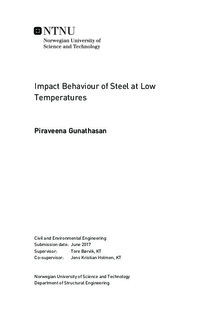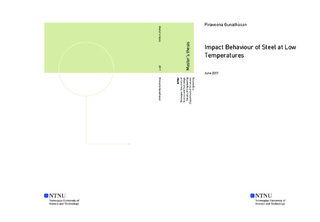| dc.description.abstract | This thesis represents a continuation of the work carried out by Susanne Thomesen during her master's thesis in 2016. The primary objectives in this thesis were to determine the ballistic properties of the high strength steel Strenx 960 Plus exposed to both ambient and cold climate, and to investigate whether the deformation and failure modes changed during ductile-to-brittle transition as the temperature was reduced. Experimental, analytical and numerical investigations were carried out.
Quasi-static tensile tests were conducted at both room temperature (RT) and -40°C. It was observed that a decrease in temperature increased the values of some certain material properties. Further, high strain rate tests were conducted in a split-Hopkinson tension bar with four different specimen geometries at RT, -40°C and -60°C.
An analytical model was developed in MATLAB where the influence of strain rate, stress triaxiality and temperature on enforcing brittle failure in the material was studied. The Cockcroft-Latham (CL) fracture criterion and the Richie, Knott and Rice (RKR) model was used to predict ductile and brittle failure, respectively. Within the considered range of the three different parameters, the material exhibited brittle failure for the highest initial stress triaxialities and for the lowest temperatures. For high strain rates the material tended to weaken due to adiabatic heating, resulting in dominance of ductile failure. A short study on other types of steels was also performed in order to determined for which material properties the probability for brittle failure was highest. Here, steels with low yield stress and low work hardening had the highest tendency to exhibit brittle failure based on the assumptions made in the analytical model.
A metallurgical study was performed to study the fracture surfaces of some selected material tests conducted at high strain rates. Tests conducted at RT, -40°and -60°C were examined through a scanning electron microscope. A classic dimple structure was observed for all specimen surfaces, indicating ductile failure.
In order to determine the ballistic properties of the material, penetration tests were carried out using both ogival and blunt nose projectiles with a nominal mass of 197 g. The tests with the blunt nose projectiles were somewhat irregular as the projectiles were damaged during testing. Tests with ogival nose projectiles were conducted at both RT and -40°C in the sub-ordnance velocity regime, in which no effect of temperature was seen for the failure mode as the target failed by ductile hole growth at both temperature levels. Ballistic limit velocity curves showed a 5% deviation between the estimated ballistic limit velocities at RT and -40°C. A small study of the penetration tests using digital image correlation (DIC) was also performed using a point tracking technique, in which good correlation was seen by comparing with the results obtained experimentally.
Lastly, a numerical study was carried out in which most of the analyses were run in Impetus Afea Solver. All models were established using 3D solid elements. Selected material tests at RT and penetration tests at both RT and -40°C with ogival nose projectiles were numerically examined. Studies of the latter proved to be strongly dependent of friction. The numerically estimated ballistic limit velocities at RT and -40°C resulted in deviations of +10% and -3.5% from the respective tests conducted experimentally, i.e both non-conservative and conservative results were obtained. | en |

